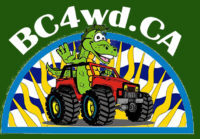This guide is part of a lesson plan I created for Spotters. I am posting it here for free use by Clubs and other not for profit organizations. At the bottom are links to the full lesson plan and a Tri-Fold handout with the Spotting Hand Signals.
A. Introduction to Spotting
A1. Definition of Spotting:
- In the context of off-road driving, Spotting is guiding the driver of a vehicle through an obstacle. An obstacle can contain one or a number of hazards.
A2. Advantages:
- The Spotter (who is usually outside the vehicle) should have a better vantage point than the Driver and therefore can better make decisions about how best to keep the vehicle on the chosen line.
- Securing, exiting, and re-entering a vehicle in the middle of an obstacle to check on a hazard can be difficult or unsafe. Having a Spotter lets the Driver avoid the need to do this.
- More eyes on the vehicle means a better chance of avoiding a serious stuck or even damage.
A3. Partnership between Driver and Spotter:
- The Driver has ultimate responsibility for their vehicle
- The Driver can Veto an offer to spot, and can choose their own Spotter.
- Everyone has the right to decline to be a Spotter.
- Spotting should be collaboration.
- If you disagree on the plan then discuss it. Don’t dismiss the Driver’s input or you may find them not following your instructions.
- When consensus between Driver and Spotter can’t be reached then the Driver has final say.
- Only the Primary Spotter communicates with the Driver. Assistant Spotters communicate to the Primary Spotter.
B. Preparation for Spotting
B1. Examine the vehicle:
- If you are not already familiar with the vehicle then take a moment to do a quick 360 to assess its capability and to check for low and vulnerable points. If you are uncomfortable at this point you may choose to request a Spotter who is more familiar with the vehicle and/or obstacle, or express your opinion on whether the vehicle should be attempting the obstacle at all. If you feel there is a probability of vehicle damage be sure to express your concerns to the Driver.
B2. If at all possible walk the obstacle with the driver:
- Observe hazards
- Discuss line choice
- Consider contingencies
- Assign Assistant Spotters if needed
B3. Confirm the plan with the Driver and Assistant Spotters:
- Before the vehicle starts moving have one last check to ensure everyone is on the same page.
- If you discussed multiple options then be very specific about what the plan for the obstacle is and don’t assume everyone remembers which of the discussed line options you ended up deciding on.
- When there is disagreement on what line to take then the Driver has final say.
B4. Review Communication and Hand Signals:
- 95% of communication with the Driver should be by hand signals. Noise from engines, bystanders, and the environment makes verbal communication unreliable.
- Make large clear hand signals
- Ideally wear Hi-Vis gloves
- Keep your hands away from your body as much as possible. If you don’t have gloves and you hold your hands in front of your tan color jacket then the Driver is not going to be able to tell what signal you are making.
- If you need to talk to the driver don’t yell from a distance, stop the vehicle and then talk.
- If you can’t position yourself where you can use hand signals then giving instructions by 2-way radio is best. If that is not an option then ensure you are close enough to the driver that they can hear you, and have an Assistant Spotter standing back further where they can better check for hazards.
- Discuss the verbal commands you will be using with the Driver
- For specifying which way to turn default to using the terms Left and Right, and remember it is always from the Driver’s point of view.
- Some people prefer to use the terms Driver Side and Passenger Side so be prepared to use them at the Driver’s request, however as this differs between Right Hand Drive and Left Hand Drive vehicles it is not what we teach.
B5. Ensure safety of yourself, assistants, and spectators:
- Inform spectators that a vehicle is about to be in motion
- Clear spectators from the path
- Ensure assistants are clear before the vehicle moves
- Avoid standing directly in the vehicle path unless you are far enough back to react in case of a loss of vehicle control.
- Have an escape route planned in case of loss of vehicle control
B6. Verify that the driver is physically and mentally prepared to drive the obstacle:
- For an experienced driver a simple thumbs up is all that is needed. For a Rookie you want to look at their face to check for signs of being too nervous to safely handle a vehicle.
C. Executing the plan
C1. Ensure a clear sight line to the Driver and ensure he can see your hands:
- The Driver may have suggestions as to where to move so he can best see you.
- 15 – 30 feet in front of the vehicle is usually far enough for the Driver to easily see you yet close enough for you to see the hazards clearly. Some obstacles will require you to be closer or farther away.
C2. Watch your step:
- Spotters tend to spend a lot of time moving around or walking ahead of the vehicle. Splitting your attention can result in falls, so unless the terrain is relatively smooth or the vehicle is moving very slowly it is best to stop the vehicle while you check a hazard or adjust your position.
C3. Move in Stages:
- For long obstacles with multiple hazards you will ideally find a position where you can guide the vehicle through to a safe stopping location, then walk (not run) to a position where you can continue to guide the vehicle to the next safe stopping location.
- Plan your spotting locations as part of your preparation.
C4. Hand off to a second Spotter if needed:
- If the obstacle does not allow for safe stopping while the Primary Spotter relocates themselves then handing off the duties of the Primary Spotter is called for.
- Plan each Spotter location as part of your preparation.
- Ensure the Driver knows when to change to the new Primary Spotter, and have the second Spotter be sure to take up spotting with large clear gestures when it is their turn.
D. Follow Up
D1. Check on the Driver:
- After the vehicle clears the obstacle briefly check with the Driver to see if they have any questions or concerns and to ensure that the Driver is confident they can carry on.
- Whether this is a hand wave, a couple of words, or a conversation will depend on the situation and the experience level of the Driver.
D2. Check for Damage:
- If there has been any significant contact between the vehicle and the hazards then there needs to be a quick vehicle 360 to check for damage.
- An experienced Driver can do this for themselves, however a Rookie should have the assistance of the Spotter or another designated person.
D3. Ensure obstacle exit is clear:
- Ensure that the Driver moves the vehicle well clear of the obstacle after they have completed it.
- How far they need to move depends primarily on how many more vehicles will be coming through before the group proceeds.
- This is especially important for “blind” situations such as hill climbs where the next Driver may not be able to see a stopped vehicle until it is too late.

